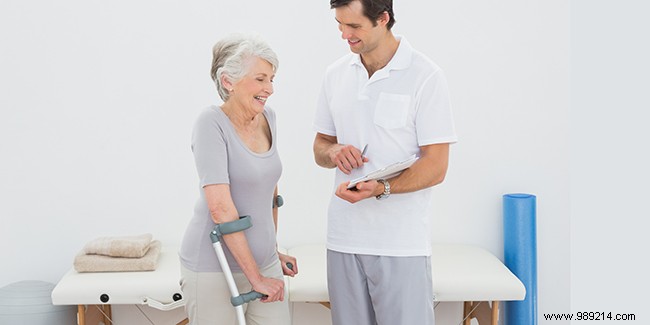
More than 100,000 people are victims of a femur fracture, more precisely of the femoral neck, each year in France. They are mainly people over the age of 60, the vast majority of whom are women. The risk of a femur fracture increases significantly with age, especially after age 80. This pathology mainly affects the elderly whose bones are weakened due to aging or illness. A fracture of the femur occurs in seniors most often following a harmless fall.
The femur refers to a long bone that is located on the inside of the thigh. At its upper end, which is ball-shaped, the femur articulates with the pelvic bone. This part is preceded by an area called the femoral neck which makes the link between the top of the femur and the trochanter, a bone mass which itself is placed between the rest of the femur and the femoral neck.
When we talk about a femur fracture, it is a break in the bone that occurs at the level of the femoral neck. When the break is located at the level of the trochanter, it is called a trochanteric fracture.
In the elderly, femur fractures most often occur following a simple fall. In this case, the person concerned feels pain that can be located in the fold of the groin, in the buttocks or at the level of the hip and which can extend to the knee. A cracking sound is also often heard. In the presence of a femur fracture, it is not possible to get up and the leg concerned appears shortened and badly positioned.
A fracture of the femur can also occur, mainly in the elderly, in the absence of a fall. In this case, this fracture is more difficult to diagnose, in particular because the leg does not show any visible deformation. On the other hand, the person can no longer lean on his leg and can no longer walk.
A fracture of the femur is detected thanks to an X-ray examination which also makes it possible to determine its severity. In some cases, it is also necessary to take the examinations further by using a scanner or magnetic resonance imaging (MRI).
In the presence of a fracture of the femur, the treatment is essentially surgical unless the patient has contraindications in terms of anesthetic products or if he is taking anticoagulant treatment. The intervention carried out by an orthopedic surgeon consists of immobilizing the fractured bone, either using specific equipment (screws, plates, etc.), or by fitting a hip prosthesis.
The treatment of a femur fracture is essentially surgical. Its objective, and in particular for the elderly, is to restore their autonomy as quickly as possible and to avoid the complications linked in particular to prolonged bed rest which can have effects on the deterioration of their state of health and cause example phlebitis, pulmonary embolism, bedsores, but also psychological disorders, food (malnutrition), etc.
Following a surgical intervention due to a fracture of the neck of the femur, medical treatment (in particular against pain and to treat the scar thanks to nursing care) and rehabilitation are put in place to allow the elderly person concerned to regain the maximum of his autonomy and in particular to walk normally again as quickly as possible.
Rehabilitation carried out by a physiotherapist, in a practice or a specialized rehabilitation establishment depending on the patient's state of health, is therefore crucial following a fracture of the femur. It improves the patient's mobility, limits balance disorders and preserves the autonomy of the elderly person as much as possible. This rehabilitation must also be supplemented by exercises to be done at home.
Most often, following an operation for a fracture of the neck of the femur, it is also necessary to adapt the person's accommodation by installing, for example, grab bars in certain rooms of the house such as the toilets or the bathroom, to replace the floor coverings with other non-slip ones. On the other hand, the intervention of third parties at home, such as home help in particular, is also most often essential.
Note:in this case, elderly people operated on for a fractured femur who depend on health insurance and who are holders of an old-age pension from the general scheme of the Pension and Occupational Health Insurance Fund ( CARSAT), can benefit, subject to resources, from financial aid, Assistance for returning home after hospitalization (ARDH).
Femur fractures are by far the most common in the elderly, from the age of 55, and more particularly in women. The risk of femur fracture increases with age and becomes very important after 80-85 years.
In younger people, this fracture of the femur bone can occur but more rarely, and mainly following a violent trauma. On the contrary, the fracture of the femur affects seniors without a sudden cause, most often following a fall which can be trivial. These falls, which are more common among the elderly, can be due to a loss of vision, balance disorders, chronic illnesses, or even osteoporosis, which weakens the bones, particularly in women.
People who have a family history of femur fracture are also more likely to be affected by this pathology, which can have serious consequences in terms of loss of autonomy, ability to move around, etc.
The prevention of femur fractures, which mainly affect the elderly whose bones are weakened due to aging or a disease such as osteoporosis, consists mainly in having a balanced diet, sufficient physical activity, or good hygiene. of life, but also to put in place all possible solutions to limit the risk of falls as much as possible.